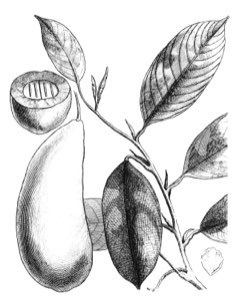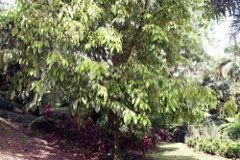 |
|
http://www.edibleplants.org |
 |
| David J. Stang wikimedia.org |
Translate this page:
Summary
Minquartia guianensis is a flowering, evergreen tree that can be found in South America and is growing up to 33 m tall and up to 120 cm in trunk diameter. The trunk is cylindrical and straight and the crown is short and oval. The flowers are in spikes located at the leaf axils. The fruit is narrowly oval, green when young and turns yellow to red when ripe. It is edible. The bark is used medicinally against malaria, colds, and intestinal parasites. It exudes white latex when damaged. The wood is used in poles and posts.
Physical Characteristics

 Minquartia guianensis is an evergreen Tree growing to 20 m (65ft) by 15 m (49ft) at a medium rate.
Minquartia guianensis is an evergreen Tree growing to 20 m (65ft) by 15 m (49ft) at a medium rate.
See above for USDA hardiness. It is hardy to UK zone 10.
Suitable for: light (sandy), medium (loamy) and heavy (clay) soils and prefers well-drained soil. Suitable pH: mildly acid, neutral and basic (mildly alkaline) soils. It can grow in full shade (deep woodland) or semi-shade (light woodland). It prefers moist soil.
UK Hardiness Map
US Hardiness Map
Synonyms
Eganthus poeppigii Tiegh. Endusa punctata Radlk. Minquartia macrophylla Ducke Minquartia parvifolia
Plant Habitats
Edible Uses
References More on Edible Uses
Medicinal Uses
Plants For A Future can not take any responsibility for any adverse effects from the use of plants. Always seek advice from a professional before using a plant medicinally.
Malaria Parasiticide
The bark has been used in the treatment of malaria, intestinal parasites, and colds[381 ].
References More on Medicinal Uses
The Bookshop: Edible Plant Books
Our Latest books on Perennial Plants For Food Forests and Permaculture Gardens in paperback or digital formats.

Edible Tropical Plants
Food Forest Plants for Hotter Conditions: 250+ Plants For Tropical Food Forests & Permaculture Gardens.
More

Edible Temperate Plants
Plants for Your Food Forest: 500 Plants for Temperate Food Forests & Permaculture Gardens.
More

More Books
PFAF have eight books available in paperback and digital formats. Browse the shop for more information.
Shop Now
Other Uses
Latex Parasiticide Wood
Agroforestry Uses: In agroforestry trials in Peru, the best establishment and growth of this tree was observed where seedlings were mixed with plantains, or on the borders of the field where neighbouring taller vegetation provided partial shade. A comparison between individuals in agroforestry trials and those in natural forests found that larger DBHs were obtained in agroforestry at a given height and that diameter growth was also higher in agroforestry trees, showing that this species can establish and thrive under these conditions. Plants grown in these agroforestry trials flowered and fruited from the age of approximately 6 years, and the fertile periods in both the flood plain and terra firma trials coincided more or less with the pattern observed in natural flood plain forests. On the basis of the results from this it was concluded that without silvicultural measures to enhance the density and growth of Minqurtia guianensis, there is only a limited ability of natural flood plain forests to supply the wood of this species[381 ]. Other Uses The fissured bark exudes a white latex when cut[420 ]. The wood is fine-textured, irregular-grained, very heavy and almost impervious to rot. A valuable timber, it is very hard to cut but is much used for external purposes such as poles, posts etc[420 ]. The wood is exceptionally durable and has been reported to have lasted 30 - 40 years in the ground without any signs of decay[381 ]. It is resistant to attacks from fungus and termites. Because of this exceptional durability, it has been extracted for subsistence and commercial purposes, mainly for posts and poles in construction[381 ].
Special Uses
References More on Other Uses
Cultivation details
Prefers a position in some shade[420 ].
References Carbon Farming Information and Carbon Sequestration Information
Temperature Converter
Type a value in the Celsius field to convert the value to Fahrenheit:
Fahrenheit:
The PFAF Bookshop
Plants For A Future have a number of books available in paperback and digital form. Book titles include Edible Plants, Edible Perennials, Edible Trees,Edible Shrubs, Woodland Gardening, and Temperate Food Forest Plants. Our new book is Food Forest Plants For Hotter Conditions (Tropical and Sub-Tropical).
Shop Now
Plant Propagation
Seed - best sown as soon as it is ripe in a partially shaded position in a nursery seedbed or in individual containers. A low germination rate can usually be expected, with the seed sprouting within 30 - 40 days[420 ]. When the seedbed sown seedlings are 4 - 5cm tall, pot them up into individual containers and they should be ready to plant out 8 - 9 months later[420 ].
Other Names
If available other names are mentioned here
Wanania, Arataweri, Alata-oedoe, Maka, Cuajado, Cuajado negro, Criollo, Crillio negro, Aquariquara roxa, black manwood, huacapu, huacapú, huambula, paini, wambula.
Native Range
SOUTHERN AMERICA: Costa Rica, Nicaragua, Panama, French Guiana, Suriname, Venezuela (Bolívar, Amazonas), Brazil (Acre, Amazonas, Pará), Bolivia, Colombia (Cauca, Caquetá, Amazonas, Vaupés), Ecuador (Esmeraldas, Napo, Pastaza, Tungurahua, Sucumbíos), Peru (Amazonas, Loreto, Madre de Dios, Pasco, Puno)
Weed Potential
Right plant wrong place. We are currently updating this section.
Please note that a plant may be invasive in one area but may not in your area so it's worth checking.
Conservation Status
IUCN Red List of Threatened Plants Status : Status: Lower Risk/near threatened

Growth: S = slow M = medium F = fast. Soil: L = light (sandy) M = medium H = heavy (clay). pH: A = acid N = neutral B = basic (alkaline). Shade: F = full shade S = semi-shade N = no shade. Moisture: D = dry M = Moist We = wet Wa = water.
Now available:
Food Forest Plants for Mediterranean Conditions
350+ Perennial Plants For Mediterranean and Drier Food Forests and Permaculture Gardens.
[Paperback and eBook]
This is the third in Plants For A Future's series of plant guides for food forests tailored to
specific climate zones. Following volumes on temperate and tropical ecosystems, this book focuses
on species suited to Mediterranean conditions—regions with hot, dry summers and cool, wet winters,
often facing the added challenge of climate change.
Read More
Expert comment
Author
Aubl.
Botanical References
Links / References
For a list of references used on this page please go here
A special thanks to Ken Fern for some of the information used on this page.
Readers comment
| Add a comment |
|
If you have important information about this plant that may help other users please add a comment or link below. Only comments or links that are felt to be directly relevant to a plant will be included. If you think a comment/link or information contained on this page is inaccurate or misleading we would welcome your feedback at [email protected]. If you have questions about a plant please use the Forum on this website as we do not have the resources to answer questions ourselves.
* Please note: the comments by website users are not necessarily those held by PFAF and may give misleading or inaccurate information.
To leave a comment please Register or login here All comments need to be approved so will not appear immediately.
|
Subject : Minquartia guianensis
|
|
|
|